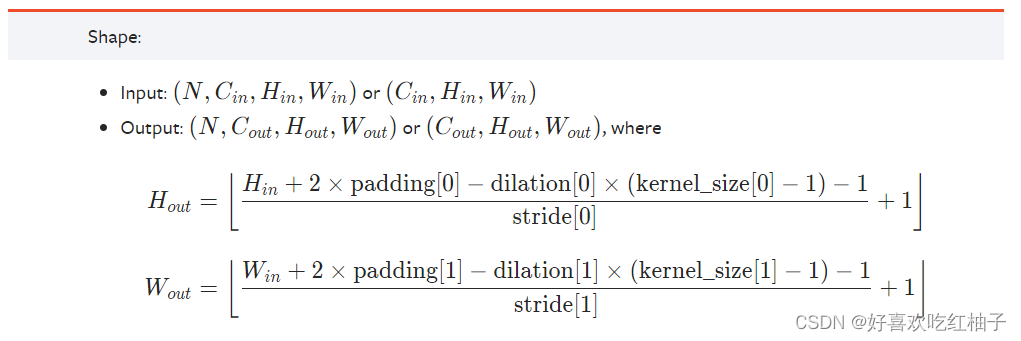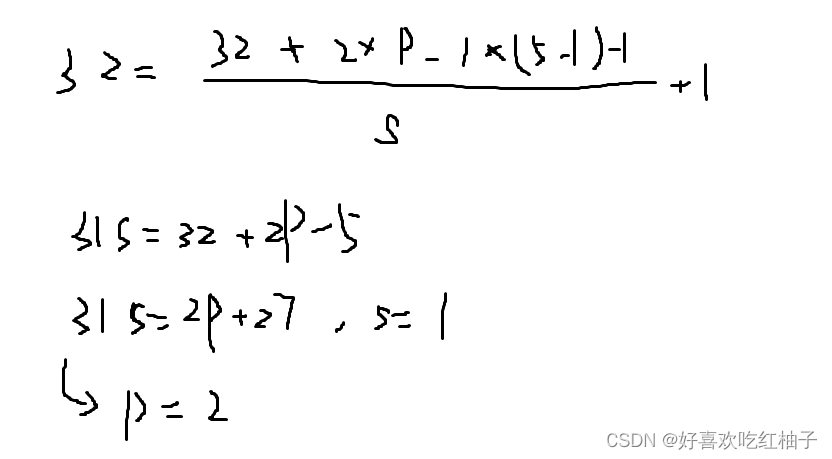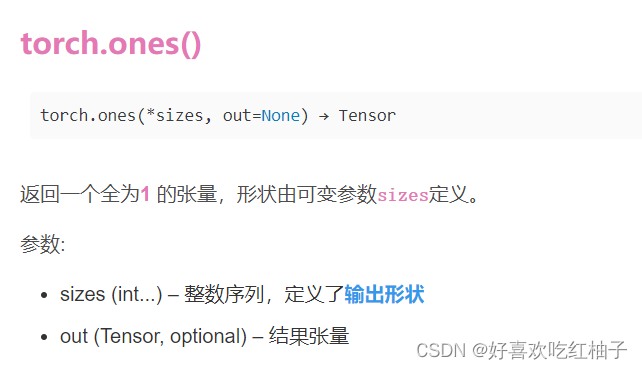目录
一、Container下Sequential层的介绍
Sequential — PyTorch 1.13 documentation
- 传入参数为module
CLASS torch.nn.Sequential(*args: Module)
- 传入参数为有序字典
1.1 作用
A sequential container. Modules will be added to it in the order they are passed in the constructor.
构建一个序列化的container,可以把想要在神经网络中添加的操作都放进去,按顺序进行执行。
1.2 Example
把卷积、非线性激活、卷积、非线性激活使用sequantial进行组合,一起放在构建的model中。
# Using Sequential to create a small model. When `model` is run,
# input will first be passed to `Conv2d(1,20,5)`. The output of
# `Conv2d(1,20,5)` will be used as the input to the first
# `ReLU`; the output of the first `ReLU` will become the input
# for `Conv2d(20,64,5)`. Finally, the output of
# `Conv2d(20,64,5)` will be used as input to the second `ReLU`
model = nn.Sequential(
nn.Conv2d(1,20,5),
nn.ReLU(),
nn.Conv2d(20,64,5),
nn.ReLU()
)
# Using Sequential with OrderedDict. This is functionally the
# same as the above code
model = nn.Sequential(OrderedDict([
('conv1', nn.Conv2d(1,20,5)),
('relu1', nn.ReLU()),
('conv2', nn.Conv2d(20,64,5)),
('relu2', nn.ReLU())
]))二、实战神经网络搭建以及sequential的使用
2.1 前期准备
2.1.1 神经网络模型
使用数据集为CIFAR10,其模型结构如下所示。

- 输入大小为3*32*32
- 经过3次【5*5卷积核卷积-2*2池化核池化】操作后,输出为64*4*4大小
- 展平后为1*1024大小
- 经过全连接层后输出为1*10
2.1.2 求卷积过程中的padding参数

在我们的第一个卷积过程中,输入通道数为3,输出通道数为32,卷积核大小为5,Conv2d所需的前三个参数已设置完成,因为没有使用空洞卷积,所示dilation默认为1,无需设置,步长stride默认为1,下面需要使用公式计算padding和stride的值为多少。

使用上述公式进行计算,把H,dilation,kernel_size进行代入,设置stride=1,padding求出=2。
如果保持输入输出的大小不变,则stride=1,padding=2,后面的卷积中都是使用该两个值,无需进行计算。
2.2 网络搭建
根据模型中的步骤进行卷积池化和全连接操作。
import torch.nn
from torch.nn import Conv2d, MaxPool2d, Flatten, Linear
class Maweiyi(torch.nn.Module):
def __init__(self):
super(Maweiyi, self).__init__()
self.conv1 = Conv2d(in_channels=3, out_channels=32, kernel_size=5, padding=2)
self.maxpool1 = MaxPool2d(kernel_size=2)
self.conv2 = Conv2d(in_channels=32, out_channels=32, kernel_size=5, padding=2)
self.maxpool2 = MaxPool2d(kernel_size=2)
self.conv3 = Conv2d(in_channels=32, out_channels=64, kernel_size=5, padding=2)
self.maxpool3 = MaxPool2d(kernel_size=2)
self.flatten = Flatten()
self.linear1 = Linear(in_features=1024, out_features=64)
self.linear2 = Linear(in_features=64, out_features=10)
def forward(self, x):
x = self.conv1(x)
x = self.maxpool1(x)
x = self.conv2(x)
x = self.maxpool2(x)
x = self.conv3(x)
x = self.maxpool3(x)
x = self.linear1(x)
x = self.linear2(x)
return x2.3 sequential的使用
可以看到上面神经网络进行搭建时非常繁琐,在init中进行了多个操作的定以后需要在forward中逐次进行调用,因此我们使用sequential方法,在init方法中直接定义一个model,然后在下面的forward方法中直接使用一次model即可。
在init方法中:
self.model1 = Sequential(
Conv2d(...)
MaxPool2d(...)
Linear(...)
)
在forward方法中:
x = self.model(x)
return x
class Maweiyi(torch.nn.Module):
def __init__(self):
super(Maweiyi, self).__init__()
self.model1 = Sequential(
Conv2d(in_channels=3, out_channels=32, kernel_size=5, padding=2),
MaxPool2d(kernel_size=2),
Conv2d(in_channels=32, out_channels=32, kernel_size=5, padding=2),
MaxPool2d(kernel_size=2),
Conv2d(in_channels=32, out_channels=64, kernel_size=5, padding=2),
MaxPool2d(kernel_size=2),
Flatten(),
Linear(in_features=1024, out_features=64),
Linear(in_features=64, out_features=10)
)
def forward(self, x):
x = self.model1(x)
return x2.4 检验网络正确性
创建输入的tensor,大小为神经网络中一开始输入的大小,为(64,3,32,32),经过神经网络后输出大小应为10。
使用torch.ones方法进行创建规定大小的tensor
(21条消息) torch.ones(),torch.add(),torch.zeros(),torch.squeeze()_skycrygg的博客-CSDN博客_torch.add()

input = torch.ones((64,3,32,32))
output = maweiyi(input)
print(output.shape)输出如下:

三、完整代码
3.1 控制台输出
import torch.nn
from torch.nn import Conv2d, MaxPool2d, Flatten, Linear, Sequential
class Maweiyi(torch.nn.Module):
def __init__(self):
super(Maweiyi, self).__init__()
self.model1 = Sequential(
Conv2d(in_channels=3, out_channels=32, kernel_size=5, padding=2),
MaxPool2d(kernel_size=2),
Conv2d(in_channels=32, out_channels=32, kernel_size=5, padding=2),
MaxPool2d(kernel_size=2),
Conv2d(in_channels=32, out_channels=64, kernel_size=5, padding=2),
MaxPool2d(kernel_size=2),
Flatten(),
Linear(in_features=1024, out_features=64),
Linear(in_features=64, out_features=10)
)
def forward(self, x):
x = self.model1(x)
return x
maweiyi = Maweiyi()
print(maweiyi)
input = torch.ones((64,3,32,32))
output = maweiyi(input)
print(output.shape)3.2 tensorboard可视化
使用SummaryWriter中的add_gragh方法生成神经网络模型 。
import torch.nn
from torch.nn import Conv2d, MaxPool2d, Flatten, Linear, Sequential
from torch.utils.tensorboard import SummaryWriter
class Maweiyi(torch.nn.Module):
def __init__(self):
super(Maweiyi, self).__init__()
self.model1 = Sequential(
Conv2d(in_channels=3, out_channels=32, kernel_size=5, padding=2),
MaxPool2d(kernel_size=2),
Conv2d(in_channels=32, out_channels=32, kernel_size=5, padding=2),
MaxPool2d(kernel_size=2),
Conv2d(in_channels=32, out_channels=64, kernel_size=5, padding=2),
MaxPool2d(kernel_size=2),
Flatten(),
Linear(in_features=1024, out_features=64),
Linear(in_features=64, out_features=10)
)
def forward(self, x):
x = self.model1(x)
return x
maweiyi = Maweiyi()
print(maweiyi)
input = torch.ones((64,3,32,32))
output = maweiyi(input)
print(output.shape)
writer = SummaryWriter("logs")
writer.add_graph(maweiyi,input)
writer.close()输出:
